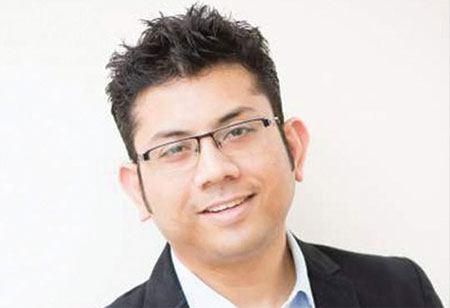By Ranjoy Dey, Digital Head, Havas Media Group

Ranjoy Dey, Digital Head, Havas Media Group
India’s online Ad market will touch 7,044 crore in 2016, an increase of 35 percent from 5,200 crore at the end of December 2015. Overall Ad spending in India will grow 15.5 percent in 2016 to 57,486 crore with digital advertising expanding at the fastest pace of 47.5 percent. Digital advertising will account for about 12.7 percent of all Ad spending in 2016, up from 9.9 percent in 2015. Print media’s share will shrink from 32.4 percent to 29.7 percent. And TV will remain the dominant medium with a 47.1 percent share, up from 46.3 percent.
Looks extremely promising for Marketers, Brands, Media houses, Agencies & Consultants alike! Of course, the established norms are getting challenged and everyone is pushed to tweak (in some cases, transform) their strategies, but overall the zing is visible in the market. Gradually, we are starting to understand that there is actually nothing called ‘digital marketing’; there is only ‘marketing in a digital word’. As consumers have started consuming content more through digital formats, sources and programs, as they are living & reflecting their lives mostly through digital platforms - suddenly we are talking about digital marketing being a core factor for not only marketing, but also market research, consumer insights, brand awareness, product placement, retail merchandising, channel development, purchase intent, positive word-of-mouth & referral and overall business impact – areas which were always considered akin to “traditional” marketing.
What’s changing? Everything. Marketers are no more looking at “digital” in a silo. They are pushing Agencies to integrate – not only media but also Creative, Formats & Content. They are probing on shelf life and impact across platforms. Agencies in turn are collaborating more and focusing on true 360o output as a competitive advantage. Television & Film Media houses are launching & promoting separate digital platforms, initially to complement existing content access, but are gradually finding it worthwhile to build it as a stand-alone platform worth its own investment in unique content. Print Media houses are pushing integrated media plans, and focusing on social media content. Radio has already gone ahead with a mix of social media and on-ground activation as its key revenue driver. Magazines soon will only exist online.
But that’s not it. Media or Marketing is not the only element that’s changing. The biggest transformation is visible in the ways Brands or Corporate houses are tracking the shift in consumer behavior, and re-engineering the way they do business. The fast development of telecom technology, increasing Internet and mobile penetration, growing acceptability of mobile payments and favourable demographics have changed many aspects of our lives – how we search for information, how we travel, how we eat, how we dress, and not at least how we shop products or services. Although classic shop-based retail is still preferred, ecommerce has gained immense ground. As per ASSOCHAM, the ecommerce industry in the country is likely to be worth $38 billion by 2016, a 67 percent jump over the $23 billion revenues for 2015. As of 2015, the retail e-commerce sales as a percent of total retail sales in India was 0.9 percent, but this is also expected to grow, reaching 1.4 percent in 2018. While the initial euphoria about ecommerce portals may have now started to plateau, the experiences of these portals in terms of sheer number of consumers, shopping behavior across categories, consumer connect, and real-time analytics are impacting the way Brands are working their current go-to-market plans across categories. In 2015, the highest growth rate for ecommerce was seen in the apparel segment almost 69.5 percent over last year, followed by electronic items by 62 percent, baby care products at 53 percent, beauty and personal care products at 52 percent and home furnishings at 49 percent. Brands, depending on where they stand in their category, are planning and executing strategies to either add eCommerce as their core competitive advantage or relaunch strategy or channel augmentation or a market entry strategy itself. As a result, not only business plans are integrating new areas such as online brand store set-up, e-tail merchandising, connecting retail & online, online distribution, and many more – but also now have possible opportunities to assign accountability on its digital & integrate marketing spends, leading to fulfillment. This in turn, is increasing positive propensity of the CXO towards higher SOV of digital & integrated marketing spends in the overall budgeting exercise.
And its visible. In 2015, search-related Ads contributed 30 percent of the total digital ad pie with 1,488 crore, followed by Ads on social media platforms like Facebook, Twitter and LinkedIn at 18 percent, or 940 crore. Spending on Video Ads such as YouTube stood at 900 crore in 2015 and accounted for 17 percent of the overall Ad spending in the digital space. This has also been driven by higher Internet speeds available to consumers coupled with an increase in mobile advertisement inventories. As these trends continue, video advertising is expected to gain further in 2016.
From a consumer perspective, its all new experiences and content! A larger number of those who view online advertisements felt that these ads helped them in finding the right product. There has been a substantial increase in the number of consumers who feel that the relevance of these ads has increased, and viewers also said that online ads were informative. In addition, use of smaller screens on personal devices will fuel ‘personal escapism’ or watching digital content individually, with 45 percent of all content consumed expected to be on the small screen by 2020, said EY in a recent report.
With the Indian Government and bureaucracy also driving adoption of digital & social media to enrich everyday lives, the true potential of consumers being engaged through digital marketing has just been unlocked!
We use cookies to ensure you get the best experience on our website. Read more...